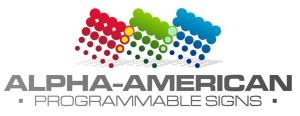Tour
Quick Tour Guide
- Welcome
- Pixels Overview
- LED Colors
- Displaying Text, Graphics, & Animation
- Programming, Hardware, & Connectivity
- Characteristics of Indoor & Outdoor Signs
- Industries Using Programmable Signs
- Applications for Retail Stores
- Call Center Benefits
- Summary of Benefits
How far away can signs be seen?
- Indoor - A rule of thumb is that for every inch of character height, the viewing distance increases by 50 feet. For instance, a 2" character can be read from 100 feet and a 12 inch character can be viewed from 600 feet.
- Outdoor - The size of the sign and the size of the characters are defined by the applications usage. A rule of thumb for determining how large characters must be to be easily read is to allow 50 feet of distance per readable inch or to allow 600 feet of distance per foot of readable text. Example in order to read a message on a sign 600 feet away, the characters and graphics in the message must be at least 12 inches high. The rule of thumb for messages viewed from an automobile is that an 18" character is required if traffic is moving 35 miles per hour, and a 12" character is required if traffic is stopped.
What's the recommended size for characters?
- Indoor - 2 inch and 4 inch high characters are commonly used in most interior applications. In warehouses or manufacturing environments, where signs are to be viewed from greater distances, 4" or 7" characters work best.
- Outdoor - 24 inch high characters are excellent for long distance freeway viewing. 14" characters are used on fast-paced streets and highways. On surface streets where traffic is slower and stopped near the sign, 8.5 inch and 12 inch characters are used.
Why shouldn't I use an indoor sign outside?
An indoor sign should not be used in an outdoor application or a window application. First, the indoor sign is not bright enough to be seen in bright daylight. Outdoor signs should be at least 100 times brighter than Indoor signs. Second, the epoxy material that indoor LED’s are made of is not designed to be exposed to sunlight. UV light will turn the LED plastic dark within a relatively short time. The effect of this is to dramatically reduce the brightness of the display. If a sign must be read in daylight, it must use superbright LED technology that is designed for UV exposure. The brightness of each pixel should be at least 800 millicandela, and the brighter the better. Some of the brightest outdoor brightness signs are rated as high as 10,000 millicandela per pixel. Indoor signs usually have a brightness between 10 to 100 millicandela per pixel. Make sure that your sign is designed for an outdoor or window application.
Also, an indoor sign enclosure is not acceptable for an exterior application. The electronics of the sign must be protected against damage from heat, cold, moisture, and airborne contaminants such as dust, salt and smog components. If a sign is to be used in an exterior environment, it should have an exterior enclosure designed to withstand the weather and environmental conditions where it is being used. Don’t overlook sprinkler systems and maintenance workers that use high pressure water hoses to clean windows and fixtures. Every sign should be protected against moisture.
|
|

